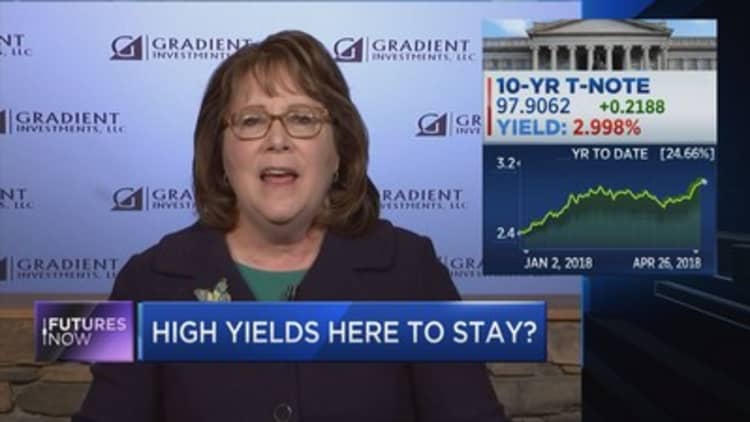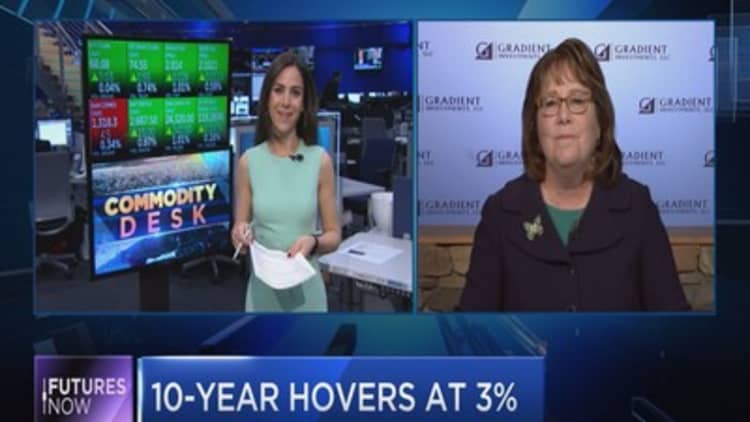
The yield on the U.S. 10-year Treasury hit its highest level in four years this week, putting upward pressure on borrowing costs and shining a spotlight on the Federal Reserve's plans to hike interest rates.
While some economists are fretting that benchmark and hope rates retreat, at least one analyst said those levels are here to stay.
"We can sustain a 3 percent type of interest rate," Mariann Montagne, senior investment analyst at Gradient Investments, told CNBC's "Futures Now" this week. She added that it's a matter of the right level at the right time.
"The rate was 2.95 [percent] back at the end of January into February. We thought then it had run too far, too fast, [and] it came back to about the 2.72 area," said Montagne.
The 10-year Treasury note began the year with a yield of 2.4 percent, and rose sharply through January and February, on worries over rising inflation. Yields caught up to 3 percent on Tuesday, topping the milestone for the first time since January 2014.
Don't blame the Fed
In the tizzy of fear over higher rates, Montagne cautioned markets to keep bond market moves in context.
"This is not the work of the Federal Reserve," said Montagne. "They have laid out their plans for slow gradual rate increases. This is what the market is dictating right now."
The move to 3 percent, she adds, does not portend a faster pace of rate hikes from the central bank. That scenario has been a major fear for markets.
"I don't think that we're really in line for much more in the way of rate hikes other than what they've laid out for us," she said, which could include at least a few more increases. "We're seeing an economy that's looking pretty good."
The Fed, under new chair Jerome Powell's leadership, has telegraphed a more hawkish approach to monetary policy this year. Markets are pricing in a 2 percent to 2.25 percent Federal Funds rate by year's end, according to CME fed funds futures. That forecast suggests another two rate hikes this year, in addition to the March increase the central bank recently meted out.
Recession worries overblown?
Worries over a flattening of the U.S. yield curve, another major market fear, appear exaggerated, Montagne added.
"People talk about it going inverted, where the number goes negative, and a lot of people associate that with an oncoming recession. We don't see that," she said.
The difference in yields of the 2-year and 10-year Treasury note, as measured by the yield curve, narrowed to a multi-year low of 41 basis points last week.
Since then, it has widened slightly to 54 basis points, but remains below the long-term average of roughly 90 basis points, says Montagne. The curve would invert if the yield on the shorter maturity rises above the longer maturity.
"It's gone negative in the past, but then it's been a year or more before there was any kind of recession," said Montagne.
The 10-year/2-year yield curve last inverted in 2006, and lasted into 2007. The U.S. economy fell into recession in December 2007.
Current economic conditions look different this time, though, Montagne insisted. The U.S. economy grew at a 2.3 percent pace in the first quarter of this year, the Commerce Department reported Friday. The U.S. has not seen a quarter of negative growth since the first quarter of 2014.
"We like to look at alternative, more true measures of recession indicators," she said. "We look at the leading economic indicators from the government and we also look at the JPMorgan index… In that index they're saying there's maybe 20 percent chance of a recession over the next several months."



